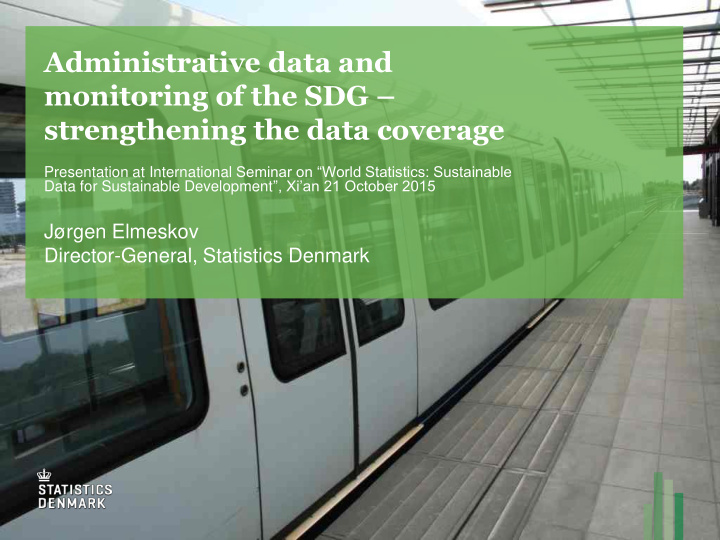



Administrative data and monitoring of the SDG – strengthening the data coverage Presentation at International Seminar on “World Statistics: Sustainable Data for Sustainable Development ”, Xi’an 21 October 2015 Jørgen Elmeskov Director-General, Statistics Denmark
Background SDG monitoring is a challenge to all countries We will approach it differently depending on our starting point: capacity, public attitudes, etc. My message: for some countries there is a big opportunity in more systematic use of administrative data Cheap and reliable monitoring of (some of) the SDGs, with a high degree of granularity Improved statistical capacity in general Improved public administration More scope for evidence-based policy 2
How does it work ? The statistical information system in Denmark Educa- Employ- tion ment CPR Person id: Inter- Tax Person Number view Question- Social naire Health Dwelling id: Enterprise id: etc Address CBR-No VAT Cadastre BDR CBR 3
What are the prerequisites? Systematic use of unique identifiers in administrative procedures Ability, right and legal clearance for the statistical institution to use and combine administrative registers NOT sophisticated IT equipment and IT developers The Danish system was launched in the 1960s and 70s, when IT capacity was miniscule compared with today and IT developers few and far between 4
What are the benefits in general? Efficient public administration This, not better statistics, was the main selling point in Denmark High quality statistics The end of sampling uncertainty Continuity, coherence and comparability of statistics Cheap statistics Census in China – 10 million census workers Census in USA – 0.5 million census workers Census in Denmark – 2 census workers (and can be conducted on a daily basis) Research opportunities based on integrated, coherent, longitudinal data Scope for improved policy design 5
And the benefits in the SDG context? Allows monitoring of many goals More on the human/social side than on the environmental side Granularity by age, gender, income, geography etc. Easy to monitor ‘ leaving no one behind ’ Continuity allows monitoring of progress Responds to the objective of capacity building 6
What are the downsides? Privacy concerns The fear of Big Brother will turn away some countries - Different levels of trust are a fact Risks associated with data security glitches - Breaches of confidentiality are bad in themselves and could jeopardise the whole ”business model” Political pressure for administrative use of statistical data Vulnerability to changes in administrative procedures 7
How to bring it about? Convincing decision makers – investments in capacity-building Establishing a legal framework to ensure adequate data protection Ensuring cooperation and unity of approach across different governmental agencies Establishing a legal framework for access by statistical institutions to administrative data 8
Summing up Administrative data can help monitor the SDG and strengthen national statistical systems in general Low costs, possibility for data disaggregation and a sound basis for evidence-based decision making are among the major benefits There are risks, but they can be overcome Administrative data provide a unique opportunity for capacity-building and ensuring national ownership of the process 9
Thank you 谢谢 10
Recommend
More recommend